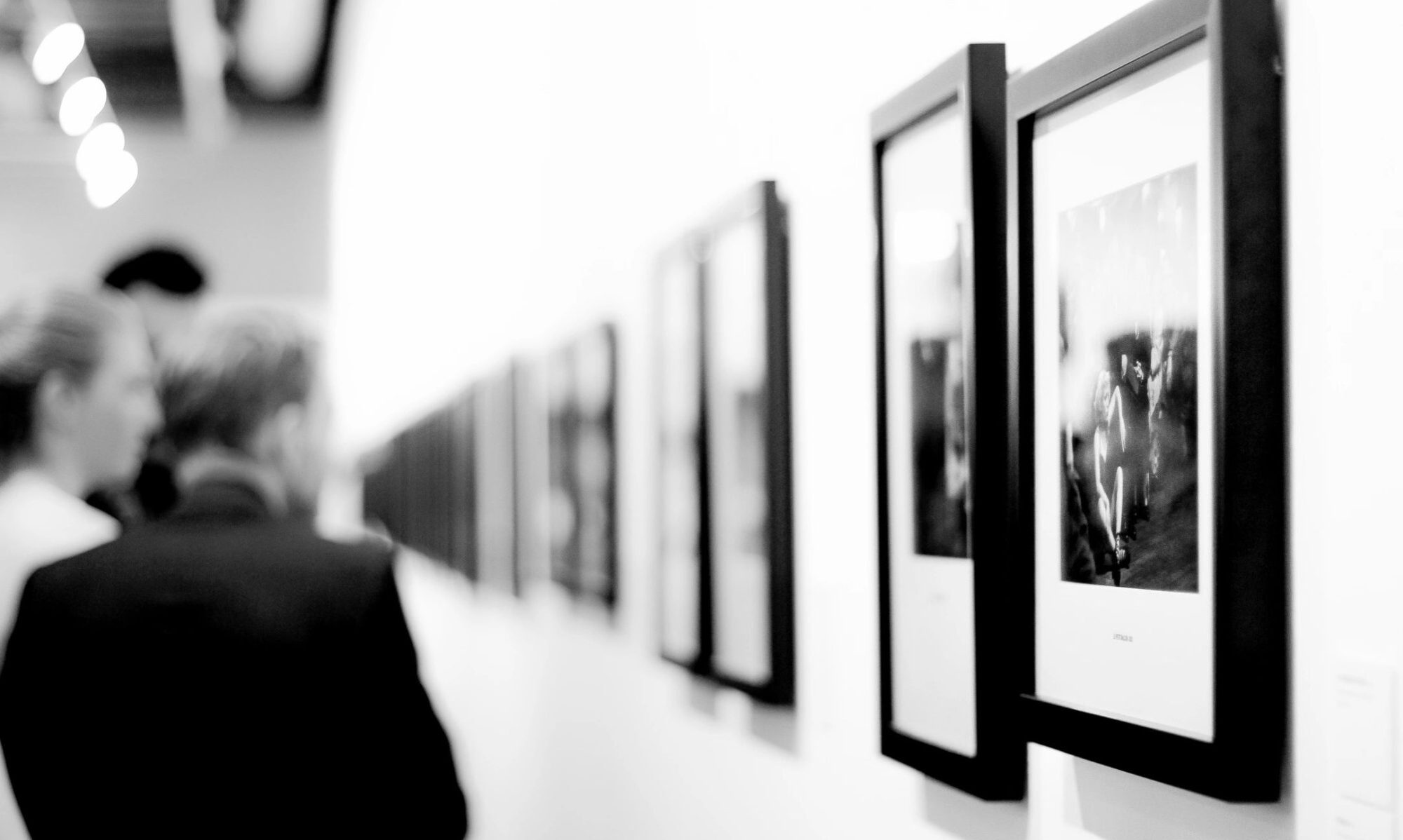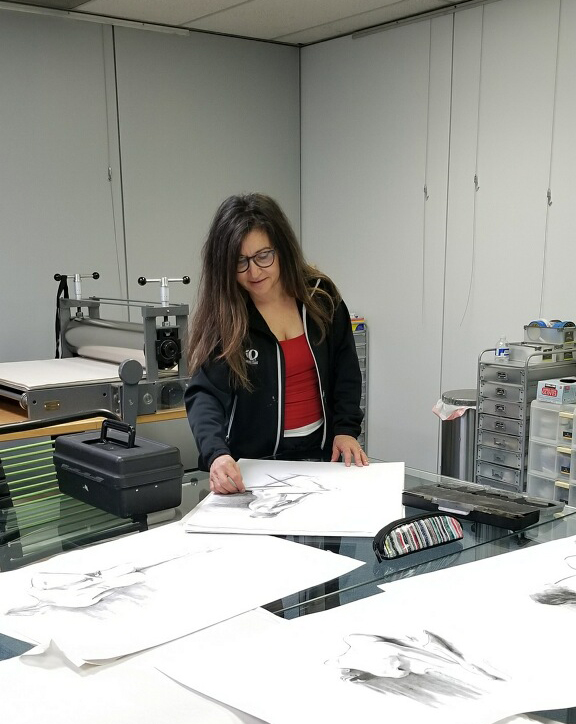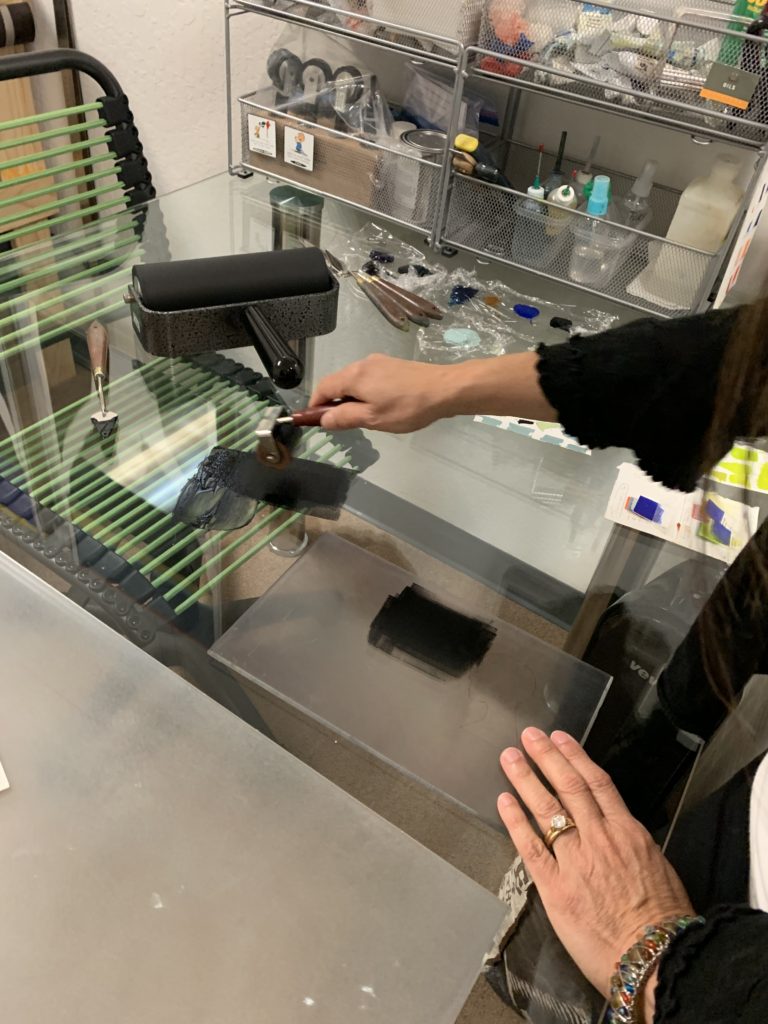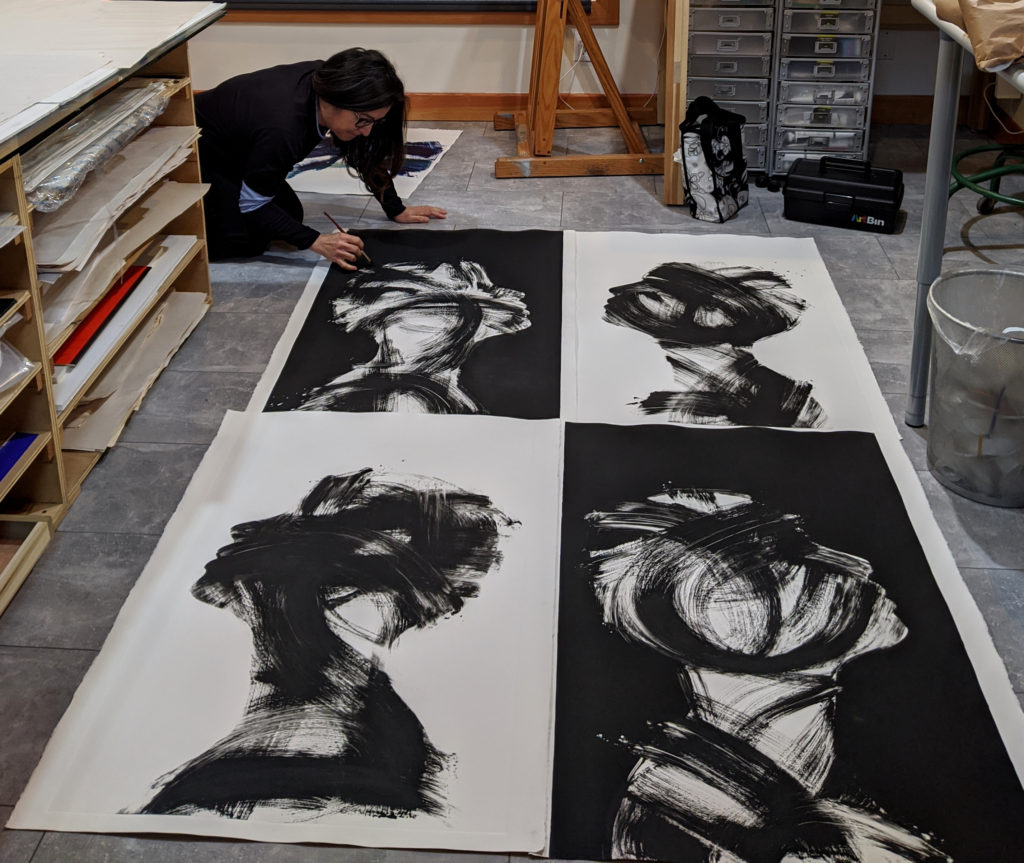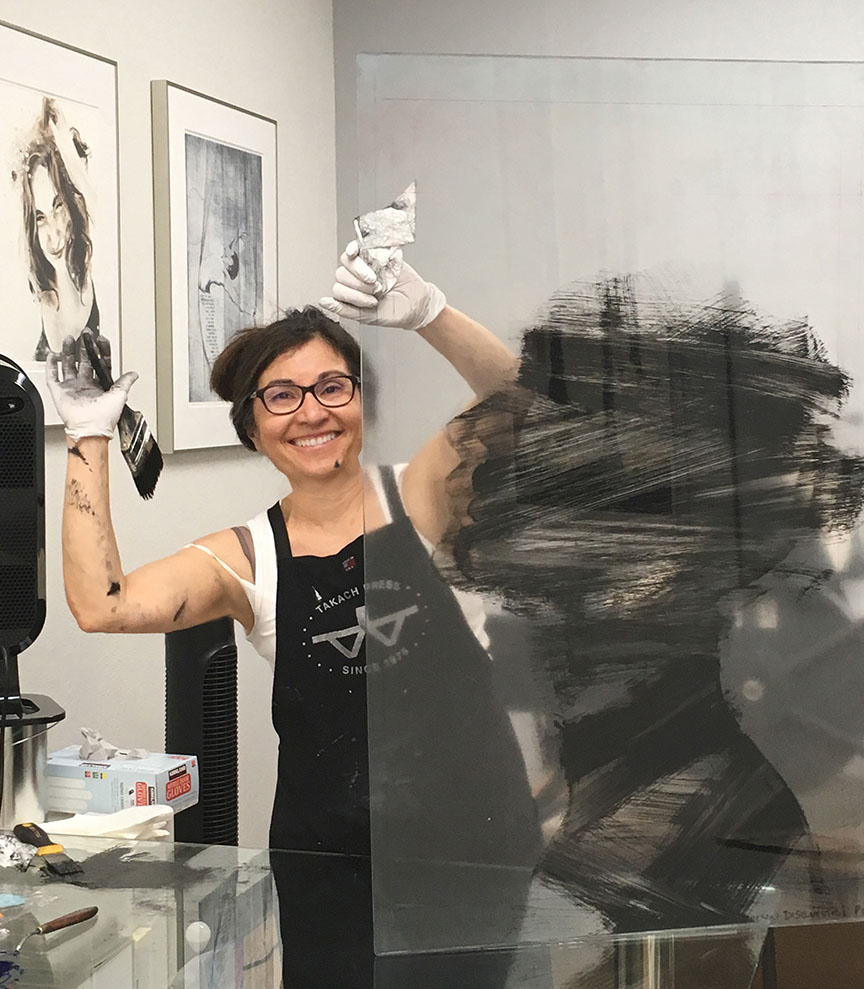31 Women – March 3rd: Rozanne Hermelyn

Unrepeated, 2020
Monoprint, oil on paper
“They say identical, but we are not. They say interchangeable, but we are individual.”
Unrepeated honors human diversity and expresses the tension and duality between what is universal and what is unique. As with every human life, no one-paint stroke is exactly the same. We may all share a common form, but we differ in race, gender, religion, sexual orientation, skills, and many other attributes. Collectives have flourished because of the innovative alchemy that occurs when diverse people and ideas merge to collaborate and create. However, in many diverse cultures the history of intolerance is long and callous. To heal intolerance, it is critical to develop prosocial skills like empathy and forgiveness, to cultivate relationships across differences, and to value individuality. Diverse communities thrive when they appreciate and protect what is universal and unique. – RH
Rozanne Hermelyn is a San Francisco Bay Area artist working in printmaking and mixed media. Since she can remember, she has painted, drawn and followed her passion for the arts. Hermelyn tells us “I’ve been creative every day most of my life. It’s like breathing – not a want, but a need.”
Growing up in Los Angeles, Hermelyn attended UCLA and Art Center College of Design, receiving a BA in design and BFA in graphic and package design, with distinction. She moved to San Francisco to begin her career and within five years became owner of Arc & Line Communications.
After twenty years in her successful design business, Hermelyn has now transitioned to focus full-time on fine art. She has been awarded Best of Show and 1st place in numerous exhibitions, her work is shown nationally and abroad, and can be found in the permanent collections of the Harvard Art Museums and the Library of Congress.
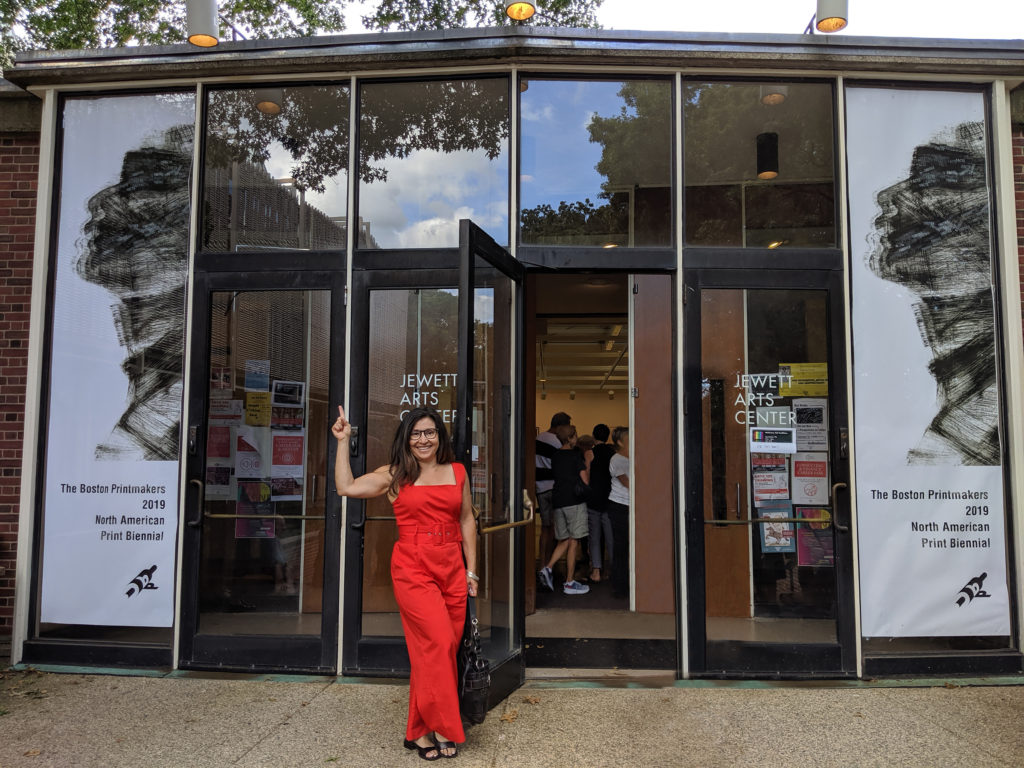
31 Women – Artist Interview with Rozanne Hermelyn
MKM: Tell me about your childhood, where did you grow up?
RH: I was born in an English colony called British Guyana in South America. My mother is Portuguese and my father is Dutch and Chinese. My parents moved our family to Los Angeles for education opportunities when I was one. You could say my life was that of a stereotypical “California Girl”; school and beach on the weekdays, and beach and work on the weekends. For my college years, I lived in Westwood, studied at UCLA and explored the Hollywood scene. Two years after graduation, I went back to art school at Art Center College of Design. Both were very exciting and explorative times in my life.
MKM: Were you always creative?
RH: My mother was an amazing and talented fashion designer and seamstress, so I was surrounded by creative energy my entire life. I remember drawing a lot when I was young and making my own clothes with her through middle school. Around 12 years old, I dragged my entire family to the Getty Museum to see the Queen’s edition drawings by Leonardo Di Vinci. Soon after, I begged my mom to let me take the life drawing class at the adult education center where she took a painting class next door. I recall being the only youth in the class and I would sit in the front row without any thought, just like a pro. I laugh now because it would not be allowed today.
MKM: Why did you pursue art?
RH: After a very successful career in design, I felt it was time to speak with my own voice.
MKM: Where did you study?
RH: I enrolled in UCLA as a math major to appease my father, but a year and half later, I secretly applied to the Design department. I ended up graduating in design without him even realizing it. Actually to this day, I have never even told him about that. After graduating, I worked for a few LA design agencies. I soon learned the fastest way to get where I wanted was to go back to art school because, of course, I wanted to be a top creative director. I was so motivated that I again secretly applied to Art Center College of Design in Pasadena. Believe it or not, Art Center would not allow me to enter a Masters program because they did not accept the BA design degree I received from UCLA. I was required to enter the undergraduate program again to earn a BFA. At the time, I didn’t care what I had to do. Fortunately, they allowed me to enter as a sophomore, which was never heard of at the time, with a full scholarship.
MKM: When you’re creating what’s your daily routine? Rituals, patterns?
RH: There is no routine in my creative process, especially in the conceptual initial phase. Sometimes an idea will come from experiences or contemplating the daily news. Sometimes it’s during a run, or in the state when I’m half awake, or in the shower. Sometimes it develops in an instant, or in a few days, or at times over years. I need to visualize the image first in my head, and it often develops right away, or sometimes over time like slow motion viewing. With every project it seems there are times I just hate the piece so I have learned to walk away, to absorb, stew, stew some more, and then jump back in. I can’t say how or when but my work always seems to need time to percolate and just become.
MKM: How has your practice changed over time?
RH: I have learned to accept and trust the images in my head and also the surprises that happen along the way. It’s all about following my gut that always leads.
MKM: Do you focus on a specific medium or combination of mediums?
RH: I wasn’t trained as a “fine artist” in art school, but I have always studied life drawing and much later, oil painting. At some point, I came upon a book about Russian-American painter Sergei Bongart whose work just spoke to me. I would study the small red book I found with his recorded lessons. I remember his words “There are two kinds of artists, the emotional painter and academician…The academician always creates something acceptable, boring, but acceptable. The emotional artist often misses, but when he/she hits, it is breathtakingly beautiful…touched by the gods!” It all made sense to me, that a great painting should express an emotional message, and that the emotional connection was equally important as color relationships and values, painting passages, and modeling light. This drew me toward the monoprint printmaking technique that I love. Every stroke and mark made is recorded and the process is full of unknown surprises.
What is your most important tool? Is there something you can’t live without in your studio?
That’s easy, my hands and eyes, but it would be difficult to live without my etching press.
MKM: Is there an artwork you are most proud of? Why?
RH: Today, I am most proud of my “Facts are Stubborn Things”. It might be because it’s my newest piece. The image speaks of my worst frustration of today’s struggle between facts and truths. Rather than factual evidence, today unwelcome truths have become the narrative of reality. Facts have become overwhelmed by false information so it’s difficult to believe that the truth will overcome. Trust has been lost to fear.
What has been a seminal experience?
My mother’s death was a seminal experience. It marks the first time I entered a series of monoprint paintings into a juried show that won the Best of Show award for the exhibition. The images portrayed moments of the experience and suffering that comes with terminal cancer. They were my tribute and my final goodbye to my mother.
What inspires you? Other artists, other women from history, your process, a theme?
Sadness, fear, anger, happiness and joy inspire me. The emotional connection when making, seeing and experiencing art is universal. It is what makes art, art.
Do you have a sense of connection to a particular woman artist from art history? Is there a specific work from this artist that you find interesting?
I feel most connected to the pop art movement, maybe because of my design background. I appreciate the hidden messages, graphic contemporary style, use of typography and simplicity of image. Idelle Weber, an American pop artist, who later switched to photorealism, is known for her figurative silhouette paintings with bright colors (think Mad Men) and later her photorealist trash and litter work. She also went through phases of monotype works and collage. I really appreciate how she reinvented herself/work from one extreme to the other. Corita Kent also did some interesting things. She was a LA pop art screen print artist in the 50s and 60s, she juxtaposed ads, street signs, billboards with poetry, scripture and song lyrics, transforming them to hopeful messages and call for action. I love anything type.
Who are your female role models from history or present day?
I respect Angelina Jolie because she’s owned her bad-girl reputation while growing into an amazing humanitarian, aiding those in need and traveling to visit those suffering in places like Pakistan, Kosovo and Syria. She confronted her risk for cancer publically and then became a poster woman for breast cancer-related issues. Did I mention, I was the ‘bad girl’ of our family, following in my older brother’s foot-steps. My two sisters were rule followers while I was forging my own path.
What’s the best piece of advice you’ve been given?
Don’t waste your time and energy convincing yourself you can’t do something, instead spend that energy doing it. Believe you can and it will happen.
